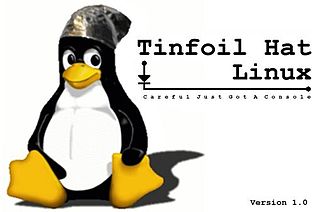Related Research Articles

In cryptography, encryption is the process of encoding information. This process converts the original representation of the information, known as plaintext, into an alternative form known as ciphertext. Ideally, only authorized parties can decipher a ciphertext back to plaintext and access the original information. Encryption does not itself prevent interference but denies the intelligible content to a would-be interceptor.
Articles related to cryptography include:
In cryptography, rubber-hose cryptanalysis is a euphemism for the extraction of cryptographic secrets from a person by coercion or torture—such as beating that person with a rubber hose, hence the name—in contrast to a mathematical or technical cryptanalytic attack.
FileVault is a disk encryption program in Mac OS X 10.3 Panther (2003) and later. It performs on-the-fly encryption with volumes on Mac computers.
The Encrypting File System (EFS) on Microsoft Windows is a feature introduced in version 3.0 of NTFS that provides filesystem-level encryption. The technology enables files to be transparently encrypted to protect confidential data from attackers with physical access to the computer.

TrueCrypt is a discontinued source-available freeware utility used for on-the-fly encryption (OTFE). It can create a virtual encrypted disk within a file, or encrypt a partition or the whole storage device.
In cryptography and steganography, plausibly deniable encryption describes encryption techniques where the existence of an encrypted file or message is deniable in the sense that an adversary cannot prove that the plaintext data exists.
Disk encryption software is computer security software that protects the confidentiality of data stored on computer media by using disk encryption.
Disk encryption is a special case of data at rest protection when the storage medium is a sector-addressable device. This article presents cryptographic aspects of the problem. For an overview, see disk encryption. For discussion of different software packages and hardware devices devoted to this problem, see disk encryption software and disk encryption hardware.
EncFS is a Free (LGPL) FUSE-based cryptographic filesystem. It transparently encrypts files, using an arbitrary directory as storage for the encrypted files.
The Linux Unified Key Setup (LUKS) is a disk encryption specification created by Clemens Fruhwirth in 2004 and originally intended for Linux.
Disk encryption is a technology which protects information by converting it into code that cannot be deciphered easily by unauthorized people or processes. Disk encryption uses disk encryption software or hardware to encrypt every bit of data that goes on a disk or disk volume. It is used to prevent unauthorized access to data storage.
Filesystem-level encryption, often called file-based encryption, FBE, or file/folder encryption, is a form of disk encryption where individual files or directories are encrypted by the file system itself.
This is a technical feature comparison of different disk encryption software.
GBDE, standing for GEOM Based Disk Encryption, is a block device-layer disk encryption system written for FreeBSD, initially introduced in version 5.0. It is based on the GEOM disk framework. GBDE was designed and implemented by Poul-Henning Kamp and Network Associates Inc..
dm-crypt is a transparent block device encryption subsystem in Linux kernel versions 2.6 and later and in DragonFly BSD. It is part of the device mapper (dm) infrastructure, and uses cryptographic routines from the kernel's Crypto API. Unlike its predecessor cryptoloop, dm-crypt was designed to support advanced modes of operation, such as XTS, LRW and ESSIV, in order to avoid watermarking attacks. In addition to that, dm-crypt addresses some reliability problems of cryptoloop.

Tinfoil Hat Linux (THL) was a compact security-focused Linux distribution designed for high security developed by The Shmoo Group. The first version (1.000) was released in February 2002. By 2013, it had become a low-priority project. Its image files and source are available in gzip format. THL can be used on modern PCs using an Intel 80386 or better, with at least 8 MB of RAM. The distribution fits on a single HD floppy disk. The small footprint provides additional benefits beyond making the system easy to understand and verify. The computer need not even have a hard drive, making it easier to "sanitize" the computer after use.
geli is a block device-layer disk encryption system written for FreeBSD, introduced in version 6.0. It uses the GEOM disk framework. It was designed and implemented by Paweł Jakub Dawidek.
Key disclosure laws, also known as mandatory key disclosure, is legislation that requires individuals to surrender cryptographic keys to law enforcement. The purpose is to allow access to material for confiscation or digital forensics purposes and use it either as evidence in a court of law or to enforce national security interests. Similarly, mandatory decryption laws force owners of encrypted data to supply decrypted data to law enforcement.
Rubber hose or Rubberhose may refer to:
References
- 1 2 Suelette Dreyfus (2012-10-29). "The Idiot Savants' Guide to Rubberhose". Archived from the original on 2012-10-29.
- ↑ Ralf Weinmann biography at https://cryptolux.org/Ralf-Philipp_Weinmann Archived September 29, 2011, at the Wayback Machine
- 1 2 "Rubberhose cryptographically deniable transparent disk encryption system". marutukku.org. Archived from the original on 16 July 2012. Retrieved 12 January 2022.